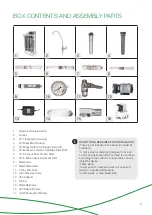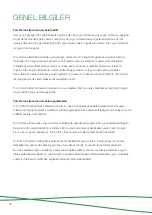
7
STAGES OF CLEAN WATER PRODUCTION IN REVERSE OSMOSIS SYSTEM
Feed water pressure must be minimum 3 bar for reverse osmosis system to work. If the feed water pressure
is not sufficient, the system can be reinforced with a pump.feed water passes through the following filtrations
respectively;
• 1st Stage: 5 micron pp sediment filter. The pre-sediment filter retains suspended materials and particles in
the water and protects successive filtrations, especially the membrane filter. (1 mm=1000 micron).
• 2nd Stage: Activated carbon filter removes pollutants, which are harmful to human health and membrane
filter, by retaining organic substances and high amounts of cancerogenic chlorine and chlorine compounds.
• 3rd stage: Block carbon filter is used for more sensitive particle filtration to retain the suspended materials in
the water.
• 4th stage: Membrane filter. The semi-permeable membrane with 8-12 angstrom pores retains bacteria,
viruses and heavy metals in the water at 95-98% and pollutant runs to the drainage through wastewater part
of membrane.
• 5th stage: Last carbon filter (post carbon). Water runs through the carbon filter at the last stage to provide
clean and extremely safe drinking water.
ION REMOVAL IN REVERSE OSMOSIS
WORKING PRINCIPLE
ION AND ORG.
PESTICIDE
REMOVAL ( % )
ION AND ORG. PES-
TICIDE
REMOVAL ( % )
Aluminum
97-98
Nickel
97-99
Ammonium
85-95
Nitrate
93-96
Arsenic
94-96
Phosphate
99+
Magnesium
96-98
Potassium
92
Bicarbonate
95-96
Radioactivity
95-98
Bromide
93-96
Radium
97
Cadmium
96-98
Selenium
97
Calcium
96-98
Silica
85-90
Chloride
94-95
Silver
95-97
Chromate
90-98
Sodium
92-98
Chromium
96-98
Sulfate
99+
Copper
97-99
Zinc
98-99
Cyanide
90-95
Boron
50-70
Fluoride
94-96
Borate
30-50
Iron
98-99
Mercury
96-98
Lead
96-98
Bacteria
99+
Mangan
96-98
Virus
99+








































